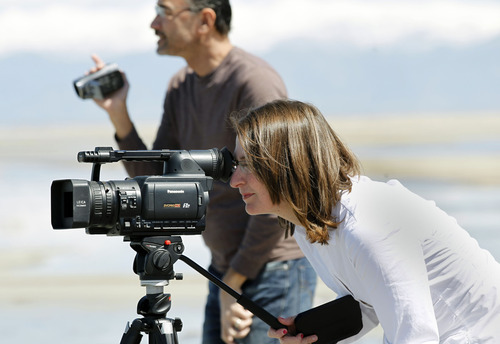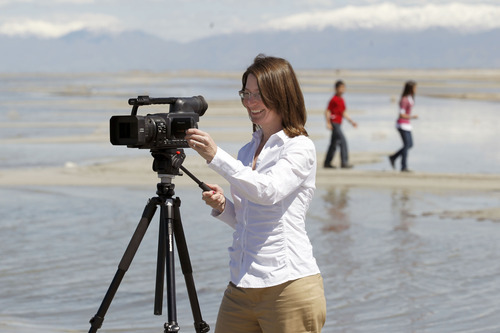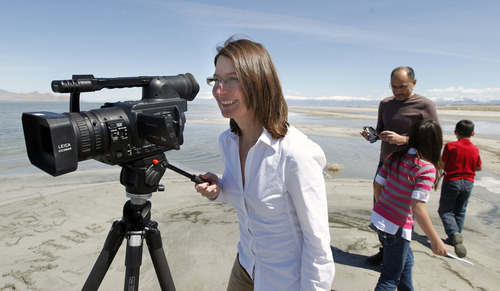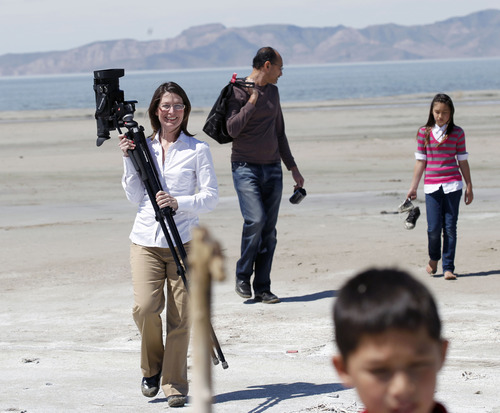This is an archived article that was published on sltrib.com in 2012, and information in the article may be outdated. It is provided only for personal research purposes and may not be reprinted.
A Utah woman has released a "work in progress" documentary to YouTube hoping to call attention to a proposal to expand mineral production on the Great Salt Lake.
Shirley Erickson Gorospe has released "Evaporating Shorelines," into which she has poured in her passions and emotions for the Great Salt Lake, its wildlife and humans who also flock there.
The hourlong video focuses on the proposal by the Great Salt Lake Minerals Corp. to significantly expand its solar evaporation pond system on the lake's north end.
"I spent all the money I had to tell this story to protect the lake," said Gorospe, a West Jordan resident.
Initially the company proposed to expand by 91,000 acres its solar evaporation pond system that uses dikes to create smaller bodies of water. But spokesman Dave Hyams said that proposal is being scaled back after comments from the public and various groups, particularly in the Bear River Bay on the lake's northeast corner.
The company is developing — but hasn't delivered a final proposal — to start the expansion at about 21,000 acres exclusively on the northwest end of the lake, Hyams said. New technology will allow it to use about 50 percent less water than it had originally sought.
Additional development would depend on whether the company meets standards of water quality and other environmental measures, he said.
"It's phased and controlled with ongoing review, which is a huge difference from what we were originally asking," he said.
Hyams called Gorospe's film "distorted, misleading propaganda" because, among other things, it focuses on a plan that is being amended.
"If that's a documentary, so is 'Harry Potter,' " he said.
The company produces sulfate of potash by evaporating Great Salt Lake waters and harvesting what's left. Sulphate of potash is a nutrient for crop fertilizers.
Gorospe said she opposes any expansion of mineral operations.
The video focuses on birds who grace the lake and on users such as sailboat owners, kayakers and bird watchers.
The Army Corps of Engineers is working on a draft environmental impact statement that could ultimately determine whether the project is carried out. A public comment period will follow the release of the draft.
"I don't want them to do any of the acres in any of the bays, ever," Gorospe said.
The Utah Division of Forestry, Fire & State Lands is in the final stages of preparing a 10-year update of its Great Salt Lake Management Plan that guides the state's approach to control of the lake but does not directly address the proposed expansion of mineral extraction.
Jason Curry, a spokesman for the agency, said the company's proposal does not expand the number of acres that could potentially be leased for mineral development but does change the designation of areas "open to leasing" to "potential" leases.
The comment period for the plan ends on April 26.
Although the state does grant mineral leases, it is the Army Corps of Engineers that has final approval, he said.
Because Great Salt Lake Minerals has yet to deliver a revision of its original proposal, Curry said it's not possible to say whether a new leasing agreement will be necessary.
"When they're finally finished, it might be a completely different proposal than what we [previously] received," he said.
Of Gorospe's documentary, he said, "There are dozens of people who feel one way or another or who are attached to one aspect of management of the lake. State law stipulates we have to take a balanced approach."













